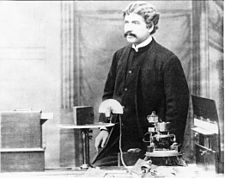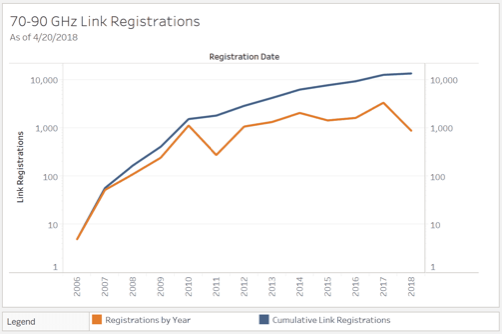
Civil Millimeter Wave
Technology and Policy
This page is devoted to the topic of civil uses of frequencies above 50 GHz. The term "millimeter waves"/mmW generally refers to frequencies in the range 30-300 GHz, where wavelengths are actually measured in millimeters. But for purpose of this discussion, we will deal only with >50 GHz.
Like the effect of the frontier on American history, the "frontier" of civil spectrum use has had an impact on the development of wireless technology. mmW is now the frontier as there are few "green field" bands in low spectrum.
The key characteristics of mmW for commercial applications were described well in a classic Microwave Journal article in 1960*. This visionary article begins,
"One of the scarcest commodities in this country today is space in the radio spectrum. The increasing requirement for broadcasting services, public and private communications, aircraft guidance, military applications and a thousand other uses of the radio spectrum has created a demand for available frequencies that far exceeds the supply. This over population of the radio spectrum has caused many to look toward the new frontier as an area for expansion of the useful radio spectrum. The part of the spectrum, known as extremely high frequencies (EHF or mmW), forms such a frontier."
mmW is different than lower bands in many ways -- some good, some challenging. Atmospheric absorption is a key characteristic of these frequencies: Like water in a microwave oven, water vapor and oxygen absorb radio power at these frequencies, heating up and dissipating the power. Note that the absorption in the graph below is in units of dB/km. Thus power from mmW transmitter decreases exponentially with distance. By contrast, at frequencies between HF and mmW power decreases with distance to a negative exponent in the range of -2 to -4, as generally happens. The net impact is a much faster decrease with distance at mmW frequencies in most cases. (See OET Bulletin No. 70 for more details.)
While this cuts down usable range of wireless systems, it also allows much greater frequency reuse than at lower frequencies. The small wavelength at these frequencies allows the use of modest size antennas (less than 1 foot) with very tightly focused beams and high gain.
While it is unlikely these bands will be used much for outdoor mobile communications, the large bandwidths available open up opportunities for fiber optic-like capacity short range systems and very broadband LANs.

Surprisingly, the history of mmW begins with Sir J.C. Bose at the University of Calcutta over a hundred years ago. (Historical paper from IMS97) (Bose is a common name in Bengal and he is not related to the Bose often paired with Einstein in quantum mechanics or the founder of Bose Corp.) Legend has it that he was assisted only by an illiterate tinsmith as he scaled down the size of Hertz's classic experiments and brilliantly showed the generation, wavelength, polarization and reception of mmW signals over distances of a few inches with only 19th century technology!
Interest in military systems, including radar systems, advanced mmW technology throughout the Cold War. But applications remained esoteric and costs were very high. The DARPA MIMIC program in the late 1980s resulted in new design and manufacturing approaches for microwave semiconductors that made commercial use plausible - as well as enabling new military applications.
History of FCC Regulations
When I came to the FCC in 1979 I was asked what technologies might be implicitly blocked by FCC rules. At the time I answered: spread spectrum, millimeter wave and adaptive antenna.
We soon started work on spread spectrum policy and started monitoring the otter two areas. I assigned a staffer to attend meeting of the DoD Advisory Group on Electronic Devices (AGED) - a key forum for discussing microwave R&D. But it became clear that in the early 1980s mmW was a far way away from commercialization.
As mentioned in the spread spectrum page, I was "rewarded" for my initiative in that area that culminated in the rules for Wi-Fi and Bluetooth by "internal exile" in FCC in the Field Operations Bureau - now the Enforcement Bureau. The work was fun and the people wonderful, but I missed the policy arena. In 1991 I was awarded an NSF grant for 6 months of research in Tokyo on Japanese spectrum issues. Almost by accident I discovered a 50 GHz system that was made by 2 Japanese manufacturers for T1 data rates or analog video. Suddenly commercial use didn't seem so far away.
(The Japanese system was developed at the urging of the Japanese regulator, MPT, which anticipated strategic reasons for commercializing this spectrum. Using "administrative guidance" MPT told the manufacturers to develop it and they made it attractive to users by greatly simplifying the usual burdensome licensing requirements for point-to-point systems in the case of 50 GHz.)
At around the same time DARPA's MIMIC program spent about $700M on basic microwave component technology that both made the pocket cell phone possible and mmW commercial use affordable. Elliot Cohen, the manager of this DARPA program, was kind enough to tutor me in the basic technology and introduce me to key technologists in the area.
I asked sources in other national regulators what was happening in millimeter wave regulations. The final key to the puzzle was a 1988 "consultative document" I received from the UK regulator in response to my inquiry.
The paper observed that the absorption permitted high frequency reuse and that unlicensed use could be an appropriate regime for using such spectrum since most of the justifications for radio licensing weren't applicable in these frequencies.

I presented my ideas for removing barriers to mmW use by following the UK suggestion of using 59-64 GHz for unlicensed systems. I pointed out that FCC rules had no licensing provisions above 40 GHz and that unlicensed systems above 38.6 GHz were forbidden. Thus a developer of mmW technology had a regulatory battle to face before he could be assured of market access.
A senior manager with differing viewpoints argued that mmW was "like a desert": the reason no one used it was not because of "lack of zoning", but rather because it was a miserable place. Brian agreed with me on this point and directed that planning proceed for a 60 GHz NPRM, later called Docket 94-124.
Docket 94-124 (59-64 and 76-77 GHz) (57-59 GHz was added some time later)
Comments
All FCC documents in docket (Some of these documents are in odd formats as they date from the early days of the FCC website and FCC use of WordPerfect)
Key documents in .pdf format:
NPRM 10/20/94 (Proposed rules)
1st R&O 12/15/95 (Adopted initial rules)
YouTube videos of FCC deliberations on Docket 94-124 from FCC archives.
(Approval video edited slightly to meet 10 minute time limit.)
10/20/94
12/15/95
Docket 02-146 (70/80/90 GHz)
Comments
NPRM (6/02)
R&O (10/03)
MO&O Docket 02-146 (3/05)
(In case you wonder why the structures above for the 2 dockets are different, 94-124 was an OET proceeding and 02-146 was a WTB proceeding. The two offices use different approaches on their web sites.)
Current FCC mmW Regulations
Licensed 70/80/90 GHz
§101.1501 Service areas. §101.1505 Segmentation plan. §101.1507 Permissible operations. §101.1511 Regulatory status and eligibility. §101.1513 License term and renewal expectancy. §101.1523 Sharing and coordination among non-government licensees and between non-government and government services. §101.1525 RF safety. §101.1527 Canadian and Mexican coordination.
NTIA Frequency Coordination Site (Coordination is required for use of this band)
NTIA Press Release on Coordination
Unlicensed Regulations
§15.255 - 57-64 GHz
§15.243 - 46.7 - 46.9 and 76 - 77 GHz (Vehicular radars)
U.S. Registration Data
(Data kindly provided by Comsearch)



"The Next Wireless Wave is a Millimeter Wave":
60-GHz CMOS Transmitter Stimulates Millimeter-Wave Developments
"CES to Showcase Wireless HDTVs", AP Wire, 1/3/08
WirelessHD group releases 60GHz radio spec, EE Times. 1/3/08
Wireless rules for Oregon courts, Government Computer News, 1/21/08
"Gadgets Gab at 60 GHz: Cheap silicon transceivers broadcasting in this still-unlicensed band may usher in the hi-def wireless home", IEEE Spectrum, 2/08
"Groups link for millimeter wave comms development", EE Times 2/08
*"Millimeters The New Radio Frontier", Microwave News 8/08, (Reprint of a classic 1960 article)
"50 Years of Millimeter-Waves: A Journey of Development", Microwave News 8/08
(Both Microwave News articles above require free registration.)
"Wireless at Fiber Speeds: New millimeter-wave technology sends data at 10 gigabits per second", Technology Review, October 2008
"The Emerging World of Massively Broadband Devices: 60 GHz and Above", Ted Rappaport's, Wireless Networking and Communications Group (WNCG) The University of Texas at Austin, keynote address at 2009 Virginia Tech Symposium on Wireless Personal Communication
"MM-waves in the Living Room: The Future of Wireless High Definition Multimedia", Microwave Journal, Vol. 52 , No.8 , August 2009 , Page 72
"45-nm CMOS for next-gen 60 GHz wireless" Electronic Products, Feb. 2010
"Wi-Fi, WirelessHD Cozy up to WiGig Standard", PCWorld, 5/10/10
"The 7Gbit WiFi Poised to Change The World", Trusted Reviews, 11/6/10
Useful Reference: OET Bulletin No. 70 (July 1997)
Millimeter Wave Propagation: Spectrum Management Implications
ETSI
millimetre Wave Transmission (mWT); Applications and use cases of millimetre wave transmission
White Paper No. 9: E-Band and V-Band - Survey on status of worldwide regulation
Manufacturers of mmW Transmission Systems/Components for Civil Markets:
BridgeWave
GigaBeam
HXI
Virginia Diodes
Vubiq


Wireless Gigabit Alliance "envisions a global wireless ecosystem of interoperable, high performance devices that work together seamlessly to connect people in the digital age. Our technology enables multi-gigabit-speed wireless communications among these devices and drives industry convergence to a single radio using the readily available, unlicensed 60 GHz spectrum."